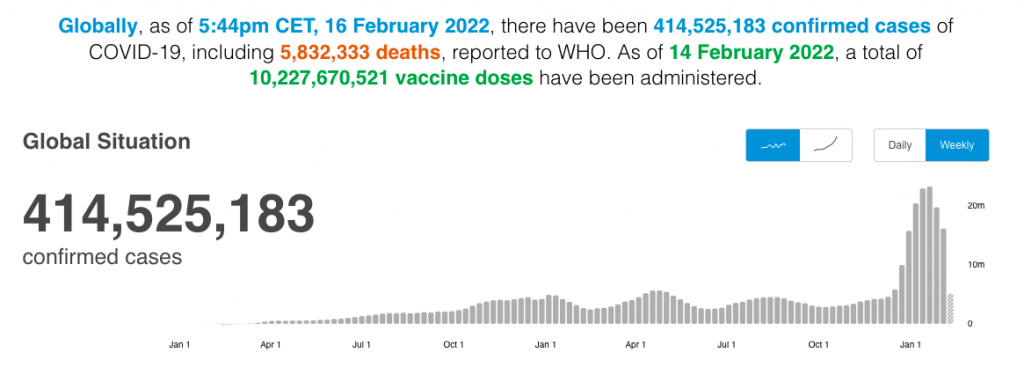The science hasn't changed but the politics have, and policymakers are responding appropriately. Transmission of the coronavirus during the Omicron wave remains at an all-time high, although infections are decreasing globally.

Denmark removed almost all pandemic restrictions on February 1 with the declaration that COVID-19 is no longer a "socially critical disease," the Danish vernacular for endemicity. Yet it continues to lead the world in the average daily rate of new infections: 736 cases per 100,000 people on February 16, according to The New York Times global tracker, down 7% from February 12 (see recent post).
Denmark is not alone, reports Fergal O'Brien, editor of Bloomberg Prognosis, with correspondents Tim Loh and James Paton on Feb. 11.
Governments are racing to scrap the last remaining pandemic measures, eager to reset the world after two years of dramatic upheaval. Even slow-mover Germany is planning to unwind curbs next week, despite setting records for infections on a daily basis.
Germany has the world's second-highest average new daily infections, over 156,000, followed by France with 136,00 and the U.S. with just over 130,000 on February 15. Russia is #1 with nearly 190,000, according to the Times tracker.
U.K. Prime Minister Boris Johnson accelerated easing plans this week, announcing that England’s final curbs would end later in February. Norway and Denmark have already ditched most restrictions. In South Africa, where the omicron variant was first identified before spreading at light speed around the world, self-isolation rules have been scrapped.
Too early?
Scientists and public health experts question the rush, particularly when transmission, while dropping nearly 40% in the last two weeks to 2 million average daily new cases on Feb. 16, according to the Times tracker, is still higher than during any of the prior surges or waves. Average daily deaths appear to have peaked at 11,000 on Feb. 9.

"Soumya Swaminathan, chief scientist at the World Health Organization, says it’s 'foolish' now to drop all precautions, add O'Brien, Loh and Paton. In a separate piece for Bloomberg, Swaminathan discusses the politicization of science and the challenge of educating people about public health: "Among public-health experts, there’s concern that politicians have missed the lessons from the crisis, particularly the on again-off again curbs, and will be caught flatfooted if and when a relapse hits."
Science hasn't changed, but politics has
Scott Gottlieb, a former FDA commissioner under President Trump and author of "Uncontrolled Spread," explained what's changed during an appearance on CBS's Face the Nation last Sunday (February 13). Italics added:
[W]e're clearly shifting from a compact where there was a shared sense of sacrifice across the population generally to take certain measures to take certain mitigation, like wearing masks, like protecting congregate settings towards one where policymakers are clearly shifting the burden onto individuals to try to protect themselves based on their own measure of their risk and the risk of their environment.
Planetizen has a tag for what Gottlieb describes: Public Health vs. Individual Rights (or Responsibility). In an endemic, the latter wins.
Related in Planetizen:
- Danish Paradox: High COVID Transmission Leads to Endemicity, February 14, 2022
- CDC Not Yet On Board with Ending Masking Requirements (blue states end mask mandates), February 13, 2022
FULL STORY: The Era of Pandemic Restrictions Is Fast Coming to an End

Study: Maui’s Plan to Convert Vacation Rentals to Long-Term Housing Could Cause Nearly $1 Billion Economic Loss
The plan would reduce visitor accommodation by 25,% resulting in 1,900 jobs lost.

North Texas Transit Leaders Tout Benefits of TOD for Growing Region
At a summit focused on transit-oriented development, policymakers discussed how North Texas’ expanded light rail system can serve as a tool for economic growth.

Using Old Oil and Gas Wells for Green Energy Storage
Penn State researchers have found that repurposing abandoned oil and gas wells for geothermal-assisted compressed-air energy storage can boost efficiency, reduce environmental risks, and support clean energy and job transitions.

Santa Barbara Could Build Housing on County Land
County supervisors moved forward a proposal to build workforce housing on two county-owned parcels.

San Mateo Formally Opposes Freeway Project
The city council will send a letter to Caltrans urging the agency to reconsider a plan to expand the 101 through the city of San Mateo.

A Bronx Community Fights to Have its Voice Heard
After organizing and giving input for decades, the community around the Kingsbridge Armory might actually see it redeveloped — and they want to continue to have a say in how it goes.
Urban Design for Planners 1: Software Tools
This six-course series explores essential urban design concepts using open source software and equips planners with the tools they need to participate fully in the urban design process.
Planning for Universal Design
Learn the tools for implementing Universal Design in planning regulations.
Ascent Environmental
Borough of Carlisle
Caltrans
Institute for Housing and Urban Development Studies (IHS)
City of Grandview
Harvard GSD Executive Education
Toledo-Lucas County Plan Commissions
Salt Lake City
NYU Wagner Graduate School of Public Service




























